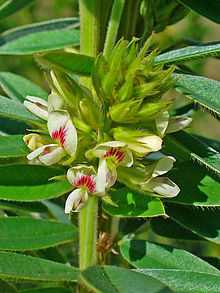Lespedeza capitata
| Lespedeza capitata | |
|---|---|
 | |
| Conservation status | |
| Scientific classification | |
| Kingdom: | Plantae |
| (unranked): | Angiosperms |
| (unranked): | Eudicots |
| (unranked): | Rosids |
| Order: | Fabales |
| Family: | Fabaceae |
| Subfamily: | Faboideae |
| Tribe: | Desmodieae |
| Genus: | Lespedeza |
| Species: | L. capitata |
| Binomial name | |
| Lespedeza capitata Michx. | |
Lespedeza capitata is a species of flowering plant in the Fabaceae, or legume family, and is known by the common name roundhead bushclover, or roundhead lespedeza.[1] It is native to eastern North America, including eastern Canada and the eastern half of the United States.[2]
This plant is a perennial herb with erect stems growing up to 1.5 meters tall. The taproot may grow over two meters deep into the soil, with lateral roots reaching out one meter horizontally. The alternately arranged leaves are each made up of several leaflets. The plant is coated in silvery hairs. Flowers are borne in somewhat rounded clusters atop each stem. The flower is white with a purple spot.[3]
In the wild this plant grows in wooded areas, on prairies, and in disturbed habitat such as roadsides. It is tolerant of drought.[4] It fixes nitrogen.[3]
This plant is used as a component of seed mixes for vegetating rangeland. It is a good addition to livestock forage, as it is palatable and nutritious.[3] The seeds are part of the diet of the Bobwhite Quail.[5] The plant can also be used in flower arrangements.[3]
This plant had a number of medicinal uses for Native American groups. It was used as a moxa to treat rheumatism. The Comanche used the leaves for tea.[5] The Meskwaki used the roots to make an antidote for poison.[6] The Pawnee people referred to the plant as rabbit foot, while the Omaha and Ponca peoples gave it the name male buffalo bellow plant.[7]
The cultivar 'Kanoka' was released by the USDA in 1998.[8]
This plant may suffer from the rust pathogen Uromyces lespedezae-procaumbentis and the tar spot fungus Phyllachora lespedezae, as well as herbivory by the insect Pachyschelus laevigatus.[8]
References
| Wikimedia Commons has media related to Lespedeza capitata. |
- ↑ Lespedeza capitata. USDA Plants Profile.
- ↑ Lespedeza capitata. Germplasm Resources Information Network.
- ↑ 3.0 3.1 3.2 3.3 Lespedeza capitata. USDA NRCS Plant Fact Sheet.
- ↑ Lespedeza capitata. Missouri Botanical Garden.
- ↑ 5.0 5.1 Lespedeza capitata. USDA NRCS Plant Guide.
- ↑ Lespedeza capitata. University of Michigan Ethnobotany.
- ↑ Lespedeza capitata. Kansas State Extension.
- ↑ 8.0 8.1 Lespedeza capitata 'Kanoka'. USDA NRCS Manhattan Plant Materials Center.
